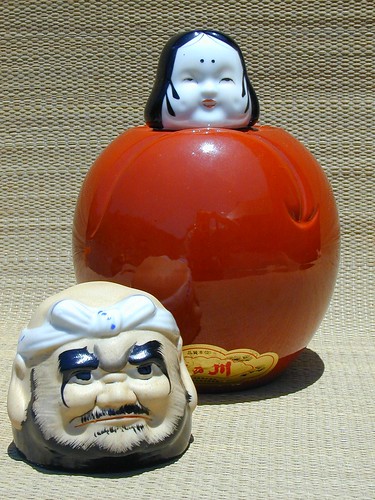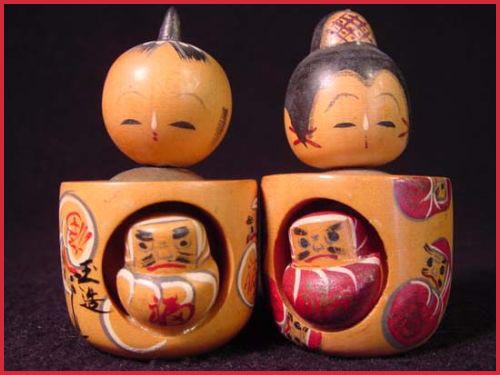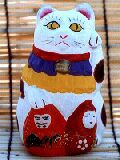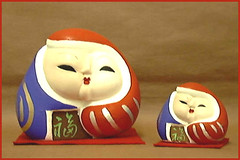[ . BACK to DARUMA MUSEUM TOP . ]
:::::::::::::::::::::::::::::::::::::::::::::::::::::::::::::::::::::::::::::::::::::::::::::::::::::
Goshiki Daruma and Color Symbols
五色だるま ― 色彩散歩
 Goshiki 五色 means "Five Colors".
The concept GOSHIKI comes from Buddhist philosphy
Goshiki 五色 means "Five Colors".
The concept GOSHIKI comes from Buddhist philosphy, so I quote part of an excellent explanation of this online dictionary:
五識
The five consciousnesses produced in connection with the five sense organs of eyes, ears, nose, tongue and skin, which take as their objects the five physical categories of form, sound, smell, taste and tactile objects: therefore, the visual consciousness 眼識, auditory consciousness 耳識, olfactory consciousness 鼻識, gustatory consciousness 舌識 and tactile consciousness 身識.
The five consciousnesses taught in the Awakening of Faith:
(1) The activity (karmic) consciousness 業識, which arises with the unenlightened mind due to original ignorance.
(2) The changing (transforming) consciousness 轉識, wherein the activity consciousness undergoes a single transformation producing the subjective view.
(3) The manifesting consciousness 現識, in which based on transformation of the activity consciousness the objective world is manifested.
(4) The knowing consciousness 智識, in which the mind creates mistaken discrimination based on its perception of the objects in the external world.
(5) The continuing consciousness 相續識, wherein, based on mistaken discrimination, the thoughts of pain and pleasure continue without abatement, thus enabling the continuity of samsara.
http://pears2.lib.ohio-state.edu/acmuller/dicts/ubdict/data/007.htm
 Daruma Dolls in five colors 五色だるま
Daruma Dolls in five colors 五色だるま
are ment to remind us of these truths all the time.
The Heart Sutra 般若心経 teaches us:
"All color is void, all void is color".
Color means worldly affairs, or on a more scholarly level, the five Skandhas.
Sutra, Sutras, Buddhist scriptures (kyoo, o-kyoo お経)
Hanya Shingyo 般若心経 Heart Sutra and more
深大寺達磨 Temple Jindaiji
Jindai-ji Temple and the Sanskrit ajikan meditation 阿字観
"During his practice of contemplation and illumination the Bodhisattva Avalokitesvara (観音菩薩) attained Truth. By means of his minutely subtle Dharma practice he penetrated the five skandhas, perceiving them as empty.....".
http://www.buddhanet.net/heartl03.htm
.................................................................................
From the Great Buddhist Dictionary (仏教大辞典、小学館) we can learn the following:
The five basic colors are
Green, Yellow, Red, White and Black.
They refer to the
five Skandhas (goshiki 五識), the
five Wisdoms (gochi 五知) or the
five Buddhas (gobutsu 五佛) as an expression of the various Buddhist teachings. In Japan there was the custom during the Heian period to hang a scroll of Buddha Amida Nyorai in front of a dying person, whith a
fivecolored string (goshiki no ito 五色の糸) coming from the hand of the Buddha extending to the hands of the person. If you hold it firmly during your last minutes, you were assured a strait passage to the Paradise of the West (Amida Joodo 阿弥陀浄土).
One of the objects in the hand of a Kannon with 1000 Hands (Senju Kannon 千手観音) is a Fivecolored Cloud (goshikiun 五色雲).
The water poured over the head of the statue of Shakyamuni as a child during the festival for his birthday on April 8 (kanbutsu-e潅仏会) is called Fivecolored Water (goshikisui 五色水).
:::::::::::::::::::::::::::::::::::::::::::::::::::::::::::::::::::::::::::::::::::::::::::::::::::::
But what are these five colors?
 Tibetan Prayer Flags
Tibetan Prayer Flags
The flags are fashioned in colors representing the elements of the universe.
Blue is the sky;
White is for the clouds;
Red is fire;
Green is water; and
Yellow is for the earth.
Each wave of the flag by the wind is considered one complete reading of the prayers printed on the flags.
http://www.karmacarpets.com/tibetan.htm
.................................................................................
 . Japanese Prayer Flags in Five Colors
. Japanese Prayer Flags in Five Colors
(goshiki ban 五色幡)
:::::::::::::::::::::::::::::::::::::::::::::::::::::::::::::::::::::::::::::::::::::::::::::::::::::
In Edo there were five temples with five identical statues of
Fudoo Myoo (Acala) (Goshiki Fudoo 五色不動) to secure supernatural power for the protection of the city from the north. The stautes only differed in the color of the eyes: The place names for the black eyed Meguro and the white eyed Mejiro are still used in Tokyo today. The red eyed was in Komagome, the yellow eyed in Komatsugawa and the green eyed in Setagaya.
Goshiki Fudo / Fudo eyes in five colors in Edo
江戸の五色不動明王
Meguro Fudo Sama 目黒のお不動さま
The most famous of these five Fudoo is the one in Meguro, where even today on the 28th of each month, the day dedicated to Fudoo, there is a huge festival and bazaar in the temple grounds where I always went to check out Daruma dolls and antiques. If you visit there, do not forget to walk around the main temple hall to the little forest in the back. There is someone waiting for you worth meeting. I will not spoil your fun by telling!
On the 28th there are also great fire rituals (goma kuyoo 護摩供養) at different hours during the day, where you can get your talismans and other belongings consecrated by Holy Fire. I once bought one talisman with the number of our car for Traffic Safety and the priest would not hand it over until it had passed the Holy Smoke. Since that day, we never had an accident with that car.
The temple compounds are quite big, with a lot of other buildings and statues to look at. One of my favorite is a stone grotto with En-no-Gyooja, the Founder of the Mountain Priests (yamabushi). I strongly recommend you visit Meguro Fudoo on any 28th day of a month, it brings back memories of OLD EDO which you have never known.
Have a look at Meguro temple.
- - quote - tomiaki/goshiki/meguro -
My Visit to
. Meguro Fudo 目黒不動 .
and Tako Yakushi TAKO Yakushi 多幸薬師
:::::::::::::::::::::::::::::::::::::::::::::::::::::::::::::::::::::::::::::::::::::::::::::::::::::
There are also some scenic areas in Japan called
GOSHIKI.
Usually they have very colorful natural sourroundings to justify this name.
The Five-colored Beach Goshiki Hama in Awaji Island 淡路島の五色浜。
. . . CLICK here for Photos !
Goshikihama Shrine in Iyo、Shikoku 伊予の五色浜神社
. . . CLICK here for Photos !
The Five-colored Swamps in Aizu, Urabandai 裏磐梯の五色沼
. . . CLICK here for Photos !
Mount Goshiki (五色岳, Goshiki-dake) is a mountain located in the Daisetsuzan Volcanic Group of the Ishikari Mountains, Hokkaido.
. . . CLICK here for Photos !
Sanuki no Goshikidai 讃岐の五色台
near Takamatsu, Shikoku
. . . CLICK here for Photos !
Goshikichoo 五色町 Goshiki Village / Town
in Hyogo
. . . CLICK here for Photos !
.................................................................................
There is a shrine at Gasshooyama 尾鑿山 Gasshoyama in Tochigi, where the stump of an old cedar tree of more than 1800 years is venerated as the deity BLACK DARUMA
Kurodaruma (黒だるま).
御神威「黒だるま」発祥の社
境内には樹齢1800年余の杉の切株が在り国内でも比類なき巨木の跡に驚く。 現在は、尾鑿山山頂の奥宮の位 置する峻厳な雄姿を象った御神威「黒だるま」。
http://www.kanuma-kanko.jp/miru/shrine_details6.shtml
:::::::::::::::::::::::::::::::::::::::::::::::::::::::::::::::::::::::::::::::::::::::::::::::::::::

The first HP I encountered checking about GOSHIKI in German was about a sort of decorative carp fish with that name.
A dark koi with red (kohaku style) hi pattern. Appears similar to an
Asagi with little or no Hi below the lateral line and a Kohaku Hi pattern over reticulated (fishnet pattern) scales.
The base color can range from nearly black to very pale sky blue.
© More in the WIKIPEDIA !
:::::::::::::::::::::::::::::::::::::::::::::::::::::::::::::::::::::::::::::::::::::::::::::::::::::
You can read all about different colors for different needs of a papermachee Daruma on this HP of
Imai Shop in Japanese and order the one you need online. They all come as papermachee with no eyes, so you can make your wish and hope for the best.
- - - - - I give you an overview:
Purple is for a long life and preventing disasters.
Green to remind you of your beginners mind all the time.
Pink for safe delivery and good relations (see story about ANZAN).
Yellow brings good luck.
Black wards off evil and brings black colors to your bank account.
White is for purity of mind and a wedding present.
Gold will bring you riches. (The chinese characters for Gold 金and Money 金 are the same.)
The Imai store also offers an opportunity to make a papermachee Daruma yourself. Or you can order a white one with your special wish or name written on the belly.
 - source : page.sannet.ne.jp/forest/imai
- source : page.sannet.ne.jp/forest/imai
:::::::::::::::::::::::::::::::::::::::::::::::::::::::::::::::::::::::::::::::::::::::::::::::::::::
Mini Daruma in Five Colors

In Pink, Yellow, Green, Red and White
カラー(ピンク・イエロー・グリーン)。赤・白はミニだるま
.................................................................................
Arai store offers Daruma in gold, silver and other colors. Have a look.
A blue and red couple for the Dolls Festival (だるま雛) is also available.
http://www.darumayahonpo.com/sakuhin/index.html
Kimura store
has a set of colorful Daruma. The black one is especially conspicious as a New Years Present for a company, since it contains a wish for Black Numbers on your balance sheet.
開運色だるま
White for Good Luck and Long Life, Yellow for Safety, Blue for peace, Black for Good Business, Purple for Long Life,
Pink for Love.
白は福寿、黄は安全、緑は健康、青は和、黒は隆盛、金は金運、紫は長寿、
ピンクは愛を願っただるまです。
:::::::::::::::::::::::::::::::::::::::::::::::::::::::::::::::::::::::::::::::::::::::::::::::::::::

Here are the Darumas in five colors from my collection. They are really quite small, only 3,5 cm large. I got them in a store in Kurashiki. For some reason, the blue one is striking purple.
私の小さい五色だるまたちです。倉敷市で2001年に購入しました。
.................................................................................

And the last one shows four of a group of five tiny Daruma in a little basket. They are only about 1 cm each.
これはミニだるまで, 高さは1cmです。五色ではなく四色しか保存されていませんでした。小さい籠に寝ています。
:::::::::::::::::::::::::::::::::::::::::::::::::::::::::::::::::::::::::::::::::::::::::::::::::::
五色に塗る餅柔かしお命講
goshiki ni nuru mochi yawarakashi o-meikoo
the mochi cakes
in five colors and so soft ...
memorial for Saint Nichiren
Hasegawa Kanajo 長谷川かな女 (1887 - 1969)
. Saint Nichiren and related KIGO
omeikoo, o-meikoo, same as oeshiki, o-eshiki 御会式(おえしき)
kigo for autumn
Buddhist festival commemorating Saint Nichiren, who passed away at Ikegami on October 13,1282.
Saijiki of Buddhist, Shinto and other Ceremonies
 source : iyokannet.jp/front/gourmet
source : iyokannet.jp/front/gourmet
goshiki soomen 五色そうめん
Somen noodles
. WASHOKU - Goshiki dishes of Japan
goshiki dorayaki 五色どらやき Dorayaki
goshiki namagashi 五色生菓子 sweets
goshiki toogarashi 五色唐辛子 red pepper
goshiki soomen 五色そうめん Somen noodles
goshiki sushi 五色寿司 Sushi
goshiki mochi 五色餅 Mochi rice cakes
. goshiki 五色と伝説 Legends about the five ritual colors .
goshikifu, goshiki fu 色麩色 Fu gluten in five colors
goshiki no hana musubi 五色の花むすび rice balls in five "blossom" colors
goshiki senso 五色鮮蔬 fresh vegetables in five colors
goshiki soomen 五色そうめん Somen noodles in five colors
:::::::::::::::::::::::::::::::::::::::::::::::::::::::::::::::::::::::::::::::::::::::::::::::::::
goshiki no ito 五色の糸(ごしきのいと)
string of five colors
negai no ito 願の糸 (ねがいのいと) "string for wishes"
..... ganshi 願糸(がんし )
for the Tanabata Star Festival
observance kigo for early autumn
. Tanabata Star Festival 七夕 .
. Gankake 願掛け to make a wish .
:::::::::::::::::::::::::::::::::::::::::::::::::::::::::::::::::::::::::::::::::::::::::::::::::::
Tsubaki Grand Shrine of America
quote
Go-Shiki / 5 color Gem Mamori Bracelet
Ame-no-Koyane-no-Mikoto and Futo-Dama-no-Mikoto brought the 500 branch true sakaki trees as offering, hanging the divine e jewels in the upper branches, the divine mirror in the mid branches and cloth offerings on the lower branches. Ame-no-Hazuchi-wo-O-Kami wove cloth of many colours, these pacificatory offerings are the origin of the Masakaki.....as for the colours, the 5 colors represent the 4 directions + center:
Mitsudomoe (symbol of Shrine Shinto) can also be called "Mikubitama" and consists of:
Black (purple) means North (Ara Mitama)
Blue (green) means East (Kushi Mitama)
Red means South (Sachi Mitama)
White means West (Nigi Mitama)
Yellow means the sacred Center (Nao-Hi =sun rays)

As Sarutahiko Okami is Kunitsu Kami Oyagami/ ancestor Kami of all Earthly Kami as well Dousoujin/Michibikikami/ Kami of the way, guidance and opening the path when we stand firmly centered on the Earth receiving sacred sunshine we can make correct progress on our individual life paths. Go-shiki-mamori bracelets mean to stand in the current moment in the divine center and receive power from Earth and Heaven. These mamori bracelets are made of very high quality hand carved gemstones. The semi precious gems are of "AA+ " grade. The power gems used are:
Black/purple = murasaki suisyo/amethyst. Highest colour vibration/ healing stone....Amethyst means both love and also stimulates the intellectual side of your life while calming your nervous system. Amethyst meaning is also reveal hidden charm and abilities.. Increases activity of right-side brain - purifies blood - reinforces immune function - increases psychic skills and intuition - peaceful mind.
Blue/ Green = Hisui/jade Calming, dispel misfortune, bravery in face of adversity, increased patience, protection of love and friendship. Jade was prized more highly than gold. green jade is the most highly sought after and its color comes from chromium.... green Jade enhances healing of both the emotional and physical. It is linked to the heart and is said to enhance prosperity and abundance and especially longevity
Red = Carnelian is to energize the blood. Excellent for both being in the moment and motivation to make correct choices, decisions and movement. Known as the most powerful ACTION gem---self-actualization--stimulating analytical capabilities, precision and motivation.
White = clear suisyo/crystal is for harmony and protection Clear Quartz has very strong powers of protection as it can absorb negative energies and harmonize KI of the wearer and enhance power. It has the ability to transmit and receive energy. In transmission, it can amplify, focus, and direct the energy. In receiving, it can store energy for later use, transform it into any usable condition, screen out unwanted vibrations and purify, calm and balance/centre one's own Ki
Yellow = Ki iro hisui/ yellow jade jade used for millennia as the ultimate symbol of calm, serene joy. Connected to spirituality, longevity, positive fortune and prosperity -- yellow jade means joy, confidence and self assurance.
source : www.tsubakishrine.org
:::::::::::::::::::::::::::::::::::::::::::::::::::::::::::::::::::::::::::::::::::::::::::::::::::
Goshiki Fudo / Fudo eyes in five colors in Edo
江戸の五色不動明王
. Goshiki jika 五色鹿 deer in five colors .
Kasuga shrine, Nara
. Goshiki suzu 五色鈴 five-colored clay bells .
..... Colors in Haiku Traditional Japanese Colors
. goshiki 五色と伝説 Legends about the five colors .
:::::::::::::::::::::::::::::::::::::::::::::::::::::::::::::::::::::::::::::::::::::::::::::::::::::
. Masaoka Shiki 正岡子規 .
夕栄の五色が浜をかすみけり
goshiki ga hama
絵の島や石も五色の花盛
goshiki no hana
宮城や五色にそろふ初霞
goshiki kasumi
星消えてあとは五色の初霞
goshiki kasumi
 source : isonokami.jp/blog
蜘の囲の五色に光る春日かな
source : isonokami.jp/blog
蜘の囲の五色に光る春日かな
kumo no i no goshiki ni hikaru harubi kana
this spring day
sparkles in five colors
in the spider web
文月のものよ五色の糸そうめん
fumizuki no mono yo goshiki no ito soomen
so good in the
seventh month - Somen noodles
in five colors
:::::::::::::::::::::::::::::::::::::::::::::::::::::::::::::::::::::::::::::::::::::::::::::::::::::
- more combination of GOSHIKI and haiku -
花見団子五色の白きより食ぶる 猿橋統流子 goshiki dango
雛の膳京の五色麩色どりに 岩田つねゑ goshiku fu
浜大根網も五色の御座の磯 鈴木公二 goshiki goza
夕栄の五色が浜をかすみけり 正岡子規 goshiki hama
山寺や五色にあまる花見堂 蓼太
goshiki hanamidoo
雲丹の針五色に動く汐干かな 栗原ゆうゆう goshiki hari
五色旗は垂りても五色秋晴るゝ 久米正雄 goshiki hata
花の雲鳩は五色に舞ひあそぶ 茅舎 goshiki hato
はひまわる五色の火蛾や楽譜書く 池内友次郎 goshiki higa
 goshiki ishi 五色石 pebbles
goshiki ishi 五色石 pebbles
拾ふ石五色揃ひぬ磯遊 井上杉香
掌に揃ふ石の五色や磯遊び 加倉井秋を
絵の島や石も五色の花盛 花盛 正岡子規
角巻や浜に拾ひし五色石 石田野武男
五色石渚に拾ふ近松忌 石田野武男
五色針糸の尾長う縫ひ初め
goshiki ito
冬茜五色の糸にみちびかれ 川崎展宏
薬玉や五色の糸の香に匂ふ 嘯山
夏の川カヌーの五色揃ひけり 大谷ひろし goshiki kanuu
風車まはり消えたる五色かな 鈴木花蓑 goshiki kazaguruma
宮城や五色にそろふ初霞 正岡子規
goshiki kasumi
星消えてあとは五色の初霞 正岡子規
梶の葉を懸けて五色の絹帷 桂樟蹊子 goshiki katabira
五色湖は女波ばかりや鳥曇 角川源義 goshiki ko - lake
手折りもす五色の香の今日の菊 石口光子 goshiki koo - incense
幕間や五色の独楽を買初に 千手和子 goshiki koma
スケーター五色の蜘蛛の散るごとし 石塚友二
goshiki kumo
蜘の囲の五色に光る春日かな 正岡子規
五色幕はりめぐらしてお取越 枌さつき goshiki maku
 goshiki mame 五色豆 beans
goshiki mame 五色豆 beans
五色豆のざらつく甘さ春の雪 鍵和田[ゆう]子
花疲れ膝にこぼせる五色豆 斎藤朗笛
春燈下紙にいただく五色豆 清崎敏郎
松過ぎの肉桂のにほふ五色豆 高澤良一
買初めの色のほのほの五色豆 高澤良一
五色饅頭青は色濃き春の風 久米正雄 goshiki manju
霊峰の風を五色に秋立てり 吉原文音 goshiki mine - peak
麦わらを口に妖婦や五色水 松瀬青々 goshiki mizu
五色に塗る餅柔かしお命講 長谷川かな女 花寂び goshiki mochi
蔵王紅葉五色の山気流れ出づ 渡辺恭子 goshiki mojimi
五色沼鴨来て色を深めけり 鈴木漱玉
goshiki numa
五色沼その瑠璃沼の明け易き 山口青邨
五色沼つなぐ小径の落し文 秋本文茶
五色沼鴨来て色を深めけり 鈴木漱玉
花薄色それぞれの五色沼 目代智子
鳥わたる豆粒ほどの五色沼 杉良介
起し絵の山紫水明五色摺り 伊藤瓔子 goshiki okoshi-e
五色縷の垂れも垂れたり肘枕 飯田蛇笏 goshiki ru (line of spittle)
切山椒五色置かれしめでたさよ 河野多希女 goshiki sansho
文月のものよ五色の絲素麺 文月 正岡子規 goshiki soomen
五色椿満開色の定まらず 塩川雄三
goshiki tsubaki
柵内に五色椿を散らしめし ふけとしこ
 goshiki uchiwa 五色団扇 handfan
goshiki uchiwa 五色団扇 handfan
五色団扇の一本を手にしつつまし 梅林句屑
夜まどゐや五色団扇の我は青 皆吉爽雨
いつしかに五色団扇も青ひとつ 福田蓼汀
羊羹の三色五色秋しぐれ 久保田万太郎 goshiki yookan
うぐいすの肺ひと呼吸に五色なす 橋本夢道 uguisu no mune
- reference : haikureikudb database -
goshiki no sen 五色の賤(ごしきのせん)outcasts
:::::::::::::::::::::::::::::::::::::::::::::::::::::::::::::::::::::::::::::::::::::::::::::::::::::
- reference : goshiki at amazon com

授業で使える「五色百人一首 goshiki hyakunin isshu
五色あられ goshiki arare - food
五色の舟 goshiki no fune
五色の花たば goshiki no hanataba
怪談五色 goshiki kaidan
五色蟹 goshiki kani
五色なげコマ goshiki koma toys
五色の虹 goshiki no niji
五色温泉 goshiki onsen
五色黄土石けん goshiki sekken
五色詠-Immortal Lovers
. . . and more at amazon com
:::::::::::::::::::::::::::::::::::::::::::::::::::::::::::::::::::::::::::::::::::::::::::::::::::::
[ . BACK to DARUMA MUSEUM TOP . ]
[ . BACK to WORLDKIGO . TOP . ]
- #goshiki #fivecolors -
:::::::::::::::::::::::::::::::::::::::::::::::::::::::::::::::::::::::::::::::::::::::::::::::::::::











































































